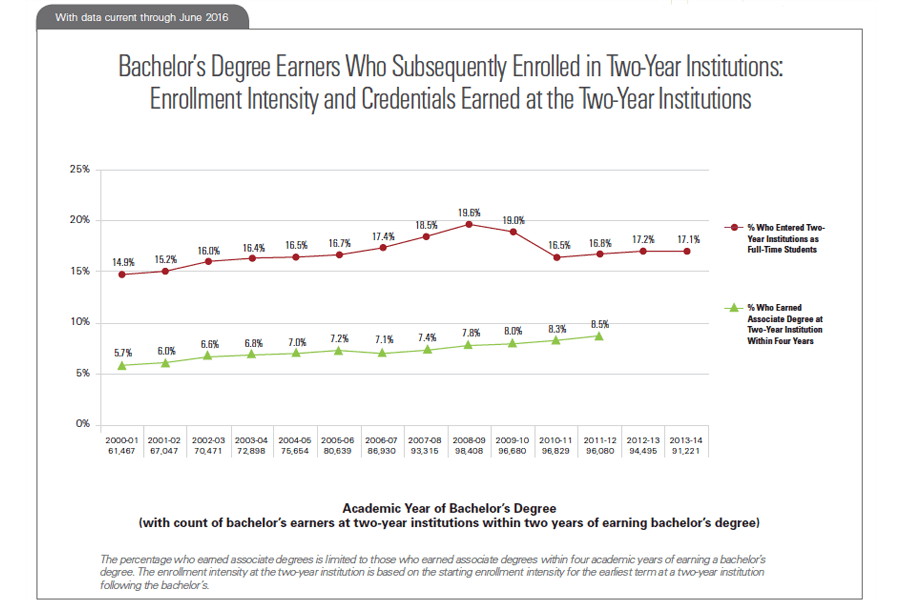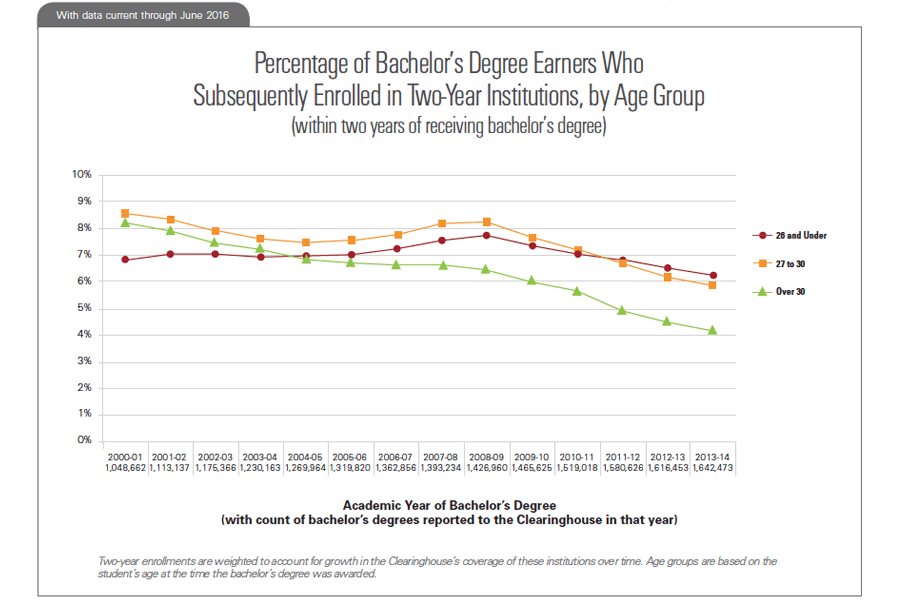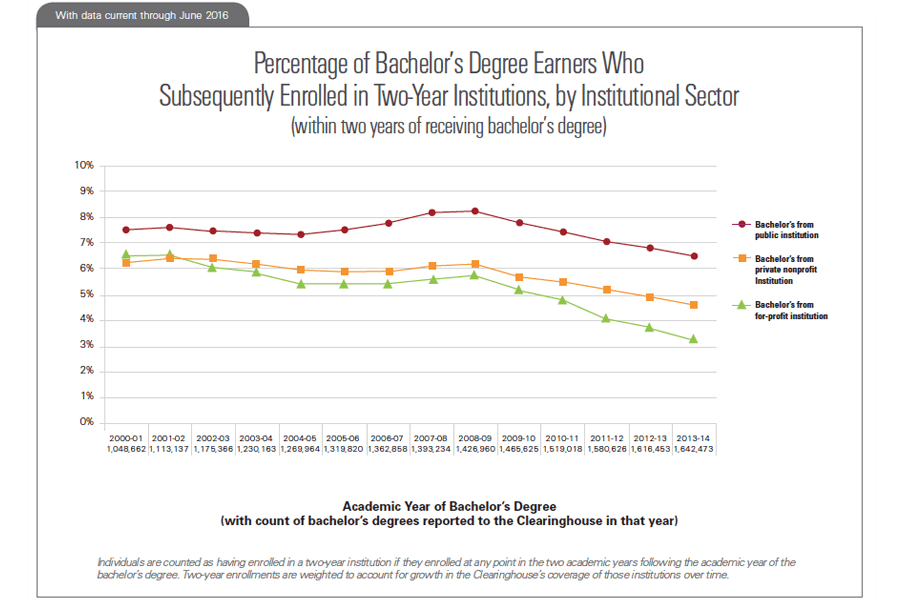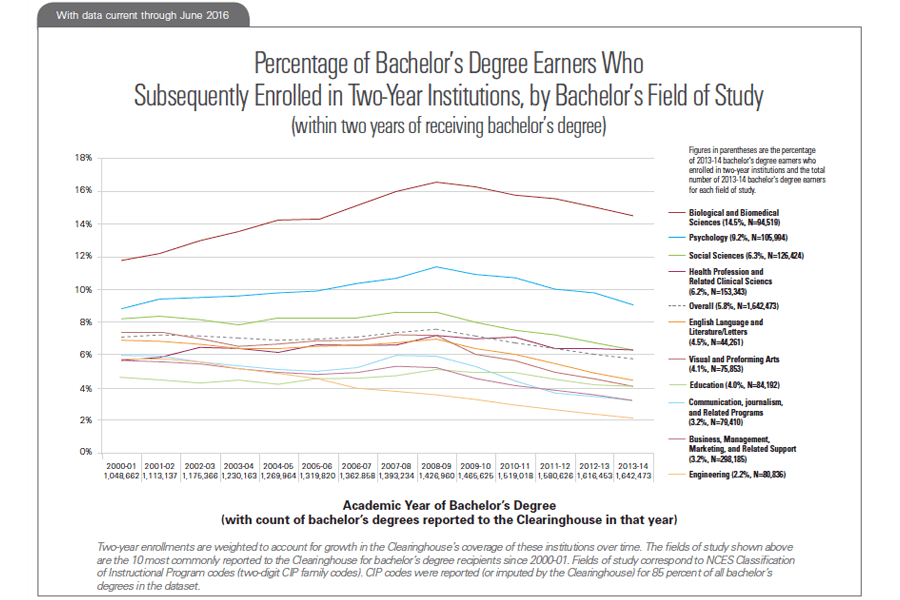
Post-Bachelor’s Two-Year Enrollment – 2016
During the Great Recession, there was a slight increase in the percentage of bachelor’s degree earners who opted to continue their educations at two-year institutions. However, that percentage has now dropped well below pre-recession levels, with only 5.8 percent of 2013-14 bachelor’s degree earners having returned to college at two-year institutions.
Supplementing the Bachelor’s Degree
During the Great Recession, there was a slight increase in the percentage of bachelor’s degree earners who opted to continue their educations at two-year institutions. However, that percentage has now dropped well below pre-recession levels, with only 5.8 percent of 2013-14 bachelor’s degree earners having returned to college at two-year institutions. Over the 14-year period of this report, the percentage of women who later enrolled in two-year institutions was 1.9 percentage points higher, on average, than that of men. That margin widened to a recession-era peak of 2.4 percentage points in 2008-09 before narrowing to 1.8 percentage points for the most recent year.

Two-Year Credentials and Enrollment Intensity
Typically, a bachelor’s degree earner who subsequently enrolls in a two-year institution will be doing so as a part-time student. On average, for the period covered in this report, only 17 percent of these students began their two-year enrollments on a full-time basis. That percentage climbed to a recession-era high of 20 percent in 2008-09, before stabilizing once again at 17 percent. Only a small percentage of the post-bachelor’s two-year enrollments resulted in an associate degree within four years, although this figure has been gradually increasing. The percentage was just 8.5 percent for 2011-12 bachelor’s degree earners, suggesting that the primary goal of enrolling in the two-year institution is more often related to industry certifications or professional licensures.

Age Group of Bachelor’s Degree Earners
For all three age groups, post-bachelor’s enrollment in two-year institutions has become less common since the end of the recession. However, the long-term trend is unique for bachelor’s degree earners over the age of 30. Unlike the other two groups, this age group did not experience a recession-era spike in post-bachelor’s enrollment in two-year institutions. This is especially notable since the over 30 age group has come to account for a larger share of all bachelor’s degrees as a result of the recession, which brought large numbers of older students back to the classroom. The over 30 group accounted for 17.5 percent of all 2013-14 bachelor’s degrees reported to the Clearinghouse, up from 14.7 percent for 2000-01. By comparison, the 26 and under group accounted for 73.5 percent of 2013-14 bachelor’s degrees, down from 76.2 percent for 2000-01, while the 27-to-30 group accounted for 9.0 percent of 2013-14 bachelor’s degrees, nearly unchanged from 9.1 percent for 2000-01.

Institutional Sector of Bachelor’s Degree
The practice of enrolling at a two-year institution after graduating with a bachelor’s degree is most common among graduates of public institutions. For the graduating class of 2013-14, 6.5 percent of bachelor’s degree earners from public institutions went on to enroll in a two-year institution within the next two academic years. The comparable percentage for graduates of private nonprofit institutions is almost two percentage points lower.

Bachelor’s Degree Field of Study
The percentage of bachelor’s degree earners pursuing additional education in a two-year institution varies widely depending on the bachelor’s degree field of study. Career fields, such as healthcare and social services, often require additional training and credentials that can be earned at two-year institutions. The figure shows two-year enrollment trends for the 10 most common fields of study for bachelor’s degree recipients. The fields are listed in descending order by the percentage of 2013-14 graduates who enrolled in two-year institutions within the next two academic years. Since the end of the recession, post-bachelor’s enrollment in two-year institutions has declined in each of the fields shown.

